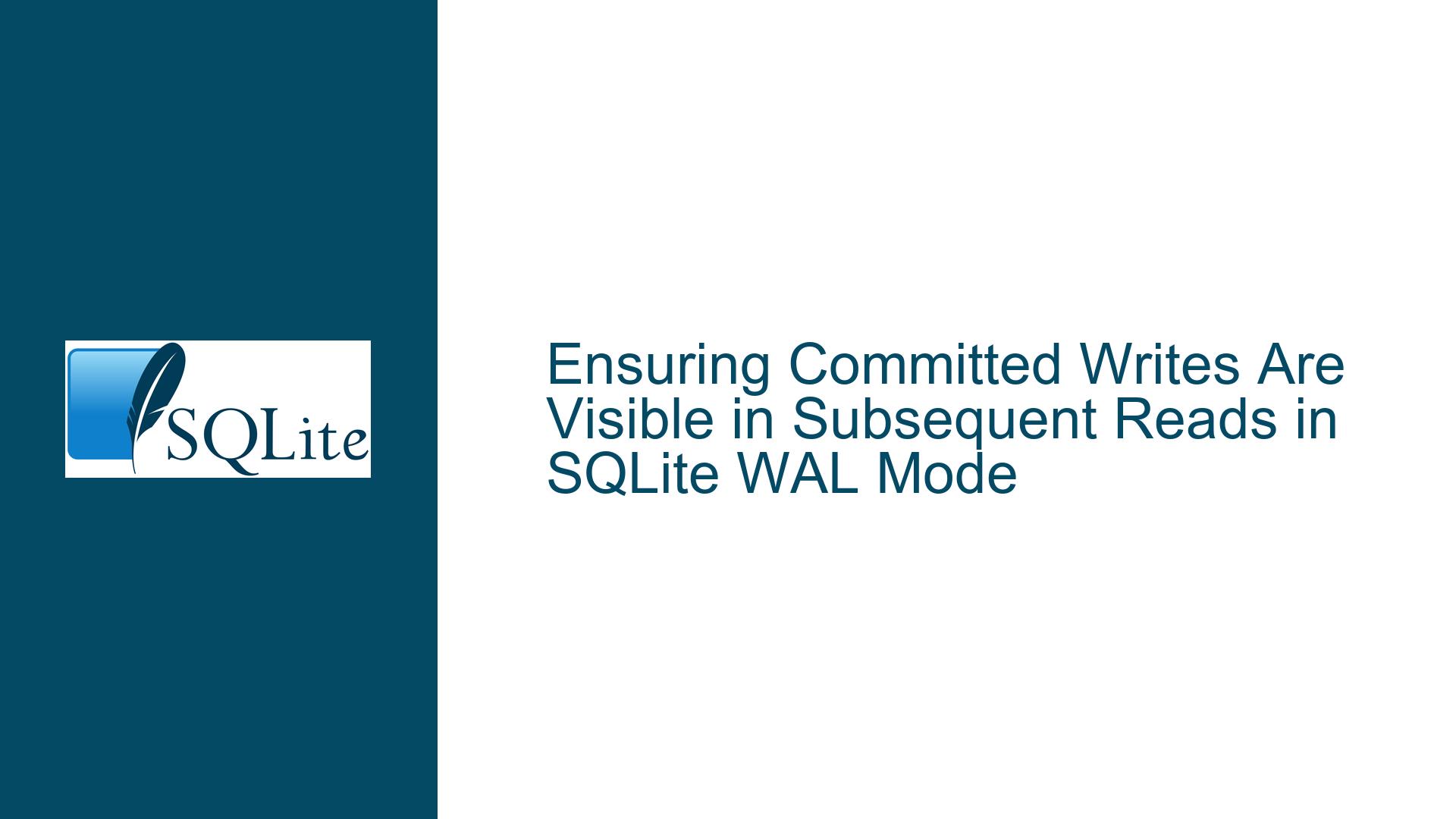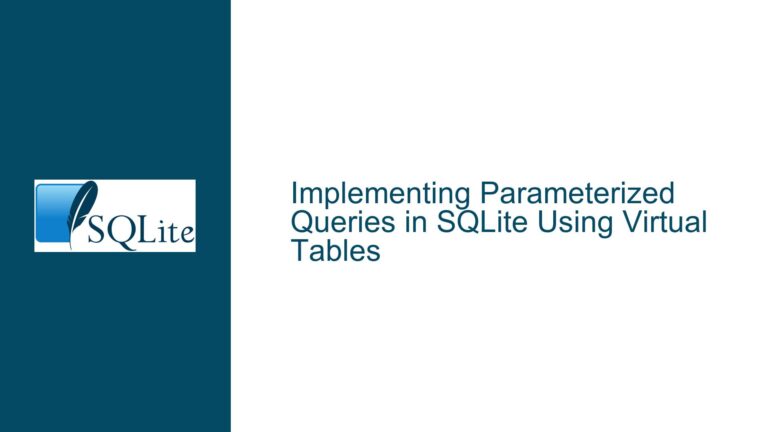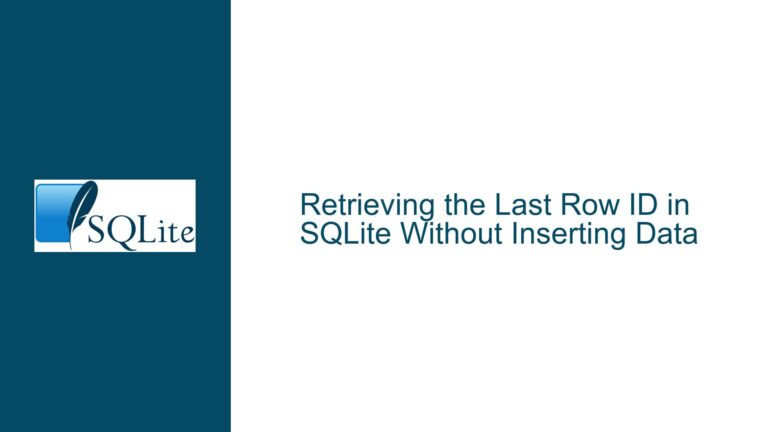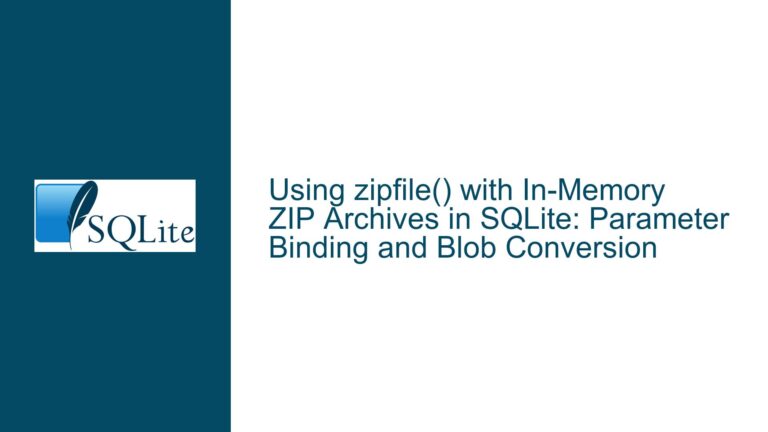Ensuring Committed Writes Are Visible in Subsequent Reads in SQLite WAL Mode
Issue Overview: Visibility of Committed Writes Across Connections in WAL Mode
SQLite’s Write-Ahead Logging (WAL) mode is designed to allow concurrent read and write operations while maintaining snapshot isolation. A common scenario involves two processes or connections interacting with the same database: one writes data (Connection X), and another reads data (Connection Y). The critical question is whether a read transaction in Connection Y, initiated after a write transaction in Connection X has committed, will always observe the changes made by Connection X.
Snapshot Isolation and WAL Mode Mechanics
In WAL mode, readers operate on a consistent snapshot of the database as it existed at the moment the read transaction began. This is enforced through a shared memory index (-wal and -shm files) that tracks active snapshots and write operations. When a read transaction starts, it captures the current state of the WAL index, ensuring it sees all transactions committed up to that point. However, this guarantee depends on several factors:
- Proper synchronization between connections to ensure the read transaction truly starts after the write transaction completes.
- No lingering read transactions in Connection Y that might hold onto an older snapshot.
- Correct implementation of VFS (Virtual File System) methods like
xShmBarrier, which enforce memory visibility across processes.
The Role of Durability and Atomic Commit
Durability in SQLite refers to the guarantee that committed transactions survive crashes. However, the visibility of committed writes to other connections is a separate concern tied to isolation levels and shared memory coordination. When Connection X commits a transaction, SQLite ensures the changes are durably written to the WAL file. For Connection Y to see these changes, it must acquire a snapshot that includes the latest committed transaction. This process is atomic only if the read transaction starts after the write transaction’s commit is fully acknowledged and synchronized.
Key Documentation Clarity
The SQLite documentation states:
"In WAL mode, SQLite exhibits ‘snapshot isolation’. When a read transaction starts, that reader continues to see an unchanging ‘snapshot’ of the database file as it existed at the moment in time when the read transaction started."
The phrase "as it existed at the moment" implicitly includes all transactions committed before the read transaction began. However, ambiguity arises when:
- The write transaction’s commit is not fully synchronized (e.g., due to
PRAGMA synchronoussettings). - The read transaction unintentionally reuses an older snapshot (e.g., due to unclosed prior transactions).
Possible Causes: Why a Read Transaction Might Not See Committed Writes
1. Lingering Read Transactions Holding Older Snapshots
If Connection Y has an open read transaction (even unintentionally), it will continue to use the snapshot it acquired when that transaction began. For example:
- A developer forgets to finalize a
SELECTstatement, leaving a read transaction open. - Connection Y uses implicit transactions (e.g., autocommit mode) but reuses the same connection without resetting its state.
In such cases, subsequent read operations in Connection Y may reuse the old snapshot, effectively ignoring the latest writes from Connection X.
2. Insufficient Synchronization Between Processes
Even if the application logic (e.g., inter-process signals) enforces ordering, SQLite relies on the operating system and VFS to propagate changes. For example:
- VFS Method
xShmBarrier: This method ensures that changes to the shared memory index (.shmfile) are visible across processes. If the VFS implementation lacks proper memory barriers (e.g., on embedded systems without atomic operations), Connection Y might not see the updated WAL index. - Filesystem Caching: The OS might cache the WAL file or database pages, delaying visibility. This is mitigated by
PRAGMA synchronous=FULLbut depends on filesystem behavior.
3. Incorrect Use of Transaction Control Statements
- Implicit vs. Explicit Transactions: If Connection Y starts a read transaction using
BEGINbut does not explicitlyCOMMITorROLLBACK, the snapshot remains active. Subsequent reads might reuse the same snapshot. - Autocommit Mode Pitfalls: In autocommit mode, each
SELECTstarts and commits a transaction. However, if Connection Y uses a prepared statement without resetting it, it might inadvertently extend the transaction’s lifespan.
4. WAL File Management and Checkpointing
- Checkpoint Operations: SQLite automatically checkpoints the WAL file to the main database when certain thresholds are met. If a checkpoint is in progress when Connection Y starts its read transaction, it might see inconsistencies.
- WAL File Size Limits: If the WAL file reaches
PRAGMA wal_autocheckpointlimits, checkpointing could interfere with snapshot visibility.
Troubleshooting Steps, Solutions & Fixes
1. Verify Transaction Boundaries and Snapshot Lifetime
Step 1: Audit Open Transactions in Connection Y
Use sqlite3_next_stmt() or database-specific tools to check for unprepared statements or open transactions. For example:
sqlite3_stmt *pStmt = nullptr;
while ((pStmt = sqlite3_next_stmt(db, pStmt)) != nullptr) {
if (sqlite3_stmt_busy(pStmt)) {
// Handle lingering statement
}
}
Step 2: Enforce Explicit Transactions
Avoid relying on autocommit mode for read transactions. Instead, use explicit BEGIN IMMEDIATE and COMMIT to control snapshot acquisition:
BEGIN IMMEDIATE;
SELECT * FROM table;
COMMIT;
Step 3: Reset Prepared Statements
Ensure all prepared statements are finalized or reset after use:
sqlite3_reset(pStmt); // Reset statement
sqlite3_clear_bindings(pStmt); // Optional
2. Ensure Proper Synchronization Across Processes
Step 1: Validate Inter-Process Signaling
If using signals or IPC to coordinate transactions, confirm that the signal is sent after the write transaction commits. For example:
// In Connection X (Writer)
sqlite3_exec(db, "COMMIT;", nullptr, nullptr, nullptr);
send_signal_to_process_Y(); // Signal after commit
Step 2: Use xShmBarrier in Custom VFS
If using a custom VFS, implement xShmBarrier to enforce memory visibility. On POSIX systems, this might involve __sync_synchronize() or std::atomic_thread_fence:
static void xShmBarrier(sqlite3_vfs *pVfs) {
__sync_synchronize(); // Memory barrier
}
Step 3: Configure PRAGMA Synchronous and Journal Mode
Set PRAGMA synchronous=FULL to ensure writes are flushed to disk before a transaction commits:
PRAGMA journal_mode=WAL;
PRAGMA synchronous=FULL;
3. Diagnose WAL File and Checkpoint Issues
Step 1: Monitor WAL File State
Use PRAGMA wal_checkpoint(TRUNCATE); to manually checkpoint and truncate the WAL file. Monitor its size with:
PRAGMA wal_autocheckpoint = 1000; // Pages, not bytes
Step 2: Disable Automatic Checkpointing Temporarily
Test visibility issues with automatic checkpointing disabled:
PRAGMA wal_autocheckpoint = 0; // Disable
Step 3: Inspect Shared Memory Content
On Linux, use hexdump to inspect the .shm file (not recommended in production):
hexdump -C your-db.shm
Look for the mxFrame field, which indicates the latest WAL frame committed.
4. Test with Minimal Reproducible Examples
Example 1: Confirming Snapshot Isolation
Writer (Connection X):
BEGIN;
INSERT INTO t1 VALUES ('test');
COMMIT;
Reader (Connection Y):
BEGIN;
SELECT COUNT(*) FROM t1; -- Should see the new row
COMMIT;
Example 2: Simulating Lingering Transactions
Writer:
INSERT INTO t1 VALUES ('test');
Reader (with open transaction):
BEGIN; -- Snapshot acquired
-- Writer commits here
SELECT COUNT(*) FROM t1; -- Does not see new row
COMMIT;
5. Platform-Specific Considerations
- Windows File Locking: Use
win32VFS withSHAREDlocking to ensure proper WAL synchronization. - Networked Filesystems: Avoid using WAL mode on NFS or SMB shares due to unreliable locking.
- In-Memory Databases:
:memory:databases do not support WAL mode across connections.
6. Advanced Debugging Techniques
Enable SQLite Debug Logging
Compile SQLite with -DSQLITE_DEBUG and enable logging:
sqlite3_config(SQLITE_CONFIG_LOG, logCallback, nullptr);
Inspect Locks and States
Query sqlite3_sourceid() to confirm all connections use the same SQLite version. Use sqlite3_db_status() to monitor cache usage.
By systematically addressing transaction boundaries, synchronization mechanisms, and WAL file management, developers can ensure that committed writes in SQLite’s WAL mode are reliably visible to subsequent read transactions.






